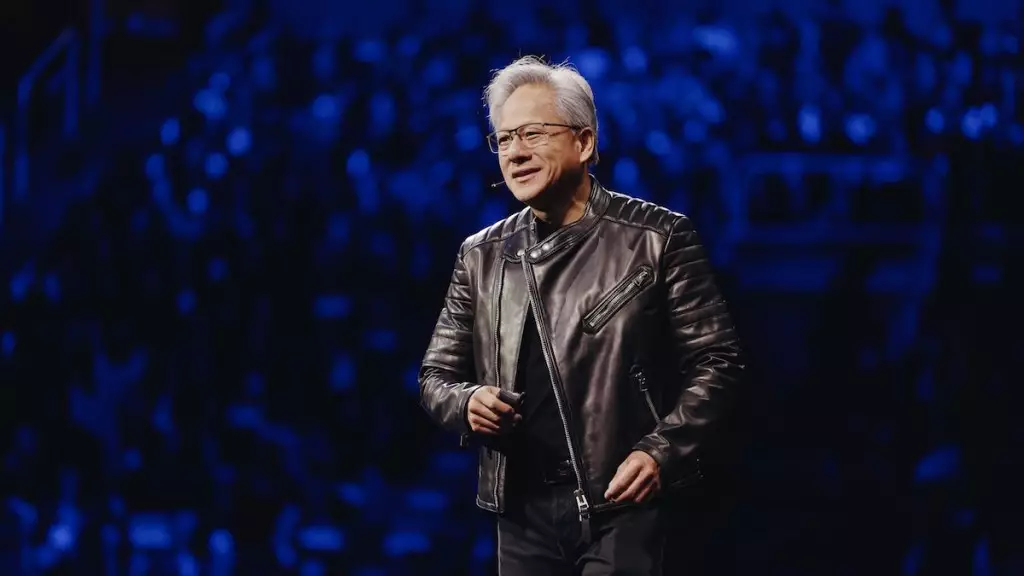In an age marked by boundless technological potential, the rise of AI is not merely a trend; it’s a necessary evolution. NVIDIA has positioned itself at the forefront of this revolution, as articulated by CEO Jensen Huang during his captivating GTC keynote. The demand for advanced, billion-parameter reasoning models is skyrocketing, reshaping how data centers operate. These facilities are no longer just servers; they’re rapidly transforming into AI factories, designed to handle millions of queries with unprecedented efficiency. Underneath this shift lies a staggering $1 trillion opportunity, prompting a race among industry leaders to innovate and adapt quickly.
NVIDIA’s bold advancements, notably the introduction of the Blackwell Ultra AI platform, symbolize a significant leap forward in this race. With a jaw-dropping 40x performance boost over its predecessor, Hopper, Blackwell is not just a technological upgrade—it’s a complete redefinition of how AI training and inference are conducted. This leap ensures that AI applications can be not only faster and more responsive but also versatile enough to cater to complex needs across various industries.
Breaking Boundaries: The Future of AI Infrastructure
NVIDIA’s roadmap marks an aggressive stride towards reshaping AI infrastructure. The commitment to an annual refresh cycle of AI architecture is an audacious strategy that underscores the urgency of technological advancement. The Vera Rubin platform, set for release in the latter half of 2026, promises enhanced data transfer speeds critical for sprawling AI systems built on numerous chips. This spirit of relentless innovation continues to progress towards the upcoming Feynman architecture anticipated in 2028, which will leverage next-gen HBM memory, further expanding the frontiers of computational capacity and efficiency.
A seismic shift is occurring not just within GPUs but across the entire AI landscape. NVIDIA’s innovations in photonics, specifically designed for AI-optimized storage and advanced networking, set a foundation for enormous improvements in scalability and energy efficiency. This readiness to embrace cutting-edge technology highlights how traditional definitions of computation are being overturned, paving the way for smarter, more streamlined operations in expansive AI ecosystems.
AI-Driven Robotics: The $50 Trillion Opportunity
The prospects presented by AI in robotics stand out as some of the most exciting developments. CEO Huang suggests that a colossal $50 trillion opportunity awaits as AI-infused automation begins to permeate various industries—manufacturing, logistics, healthcare, and beyond. NVIDIA’s Isaac and Cosmos platforms exemplify the ambition to harness AI’s capabilities to rethink and revolutionize how industries function.
These platforms are designed not just to facilitate automation but to create systems that adapt and learn dynamically. The potential to overhaul entire industries through AI-powered robotics is disarming yet thrilling. This reimagining of the industrial landscape materializes in the form of smarter manufacturing processes and enhanced logistical frameworks, all of which are driven by NVIDIA’s cutting-edge technology.
Democratizing AI Innovation with Open-Source Solutions
In an era when innovation often seems the domain of Silicon Valley elites, NVIDIA’s release of the open-source Dynamo software speaks volumes about its accessibility-minded approach. This initiative fosters collaboration and learning, accelerating the innovation cycle for AI factories. By lowering the barriers to entry, NVIDIA empowers developers and researchers alike, equipping them with tools to refine and optimize AI models swiftly.
Moreover, the establishment of the NVIDIA Accelerated Quantum Research Center in Boston is a bold move that signals the importance of collaboration in advancing quantum computing. By working alongside leading hardware and software developers, NVIDIA emphasizes the necessity of shared knowledge and innovation in a rapidly evolving field.
Setting the Stage for Intelligent Robotics
Lastly, NVIDIA’s unveiling of the GR00T N1 humanoid robot model represents a transformative shift in the robotics landscape. As the world’s first open, fully customizable model for humanoid reasoning, GR00T N1 leverages dual reasoning systems, mimicking human cognitive patterns and enhancing its ability to navigate complex tasks. This kind of innovation is not just a benchmark; it’s a game-changer. Alongside this, the Newton Physics Engine collaboration with Google DeepMind and Disney Research opens a new frontier where robots can refine their skills in real-time, ensuring they perform tasks with greater accuracy and adaptability.
With these advancements, NVIDIA is not only heralding a future ripe with potential; it’s actively crafting a narrative of how technology can reshape humanity’s engagement with the world. As AI becomes more prevalent, NVIDIA’s leadership and visionary direction could very well determine the trajectory of this remarkable journey into a smarter, more efficient future.


Leave a Reply